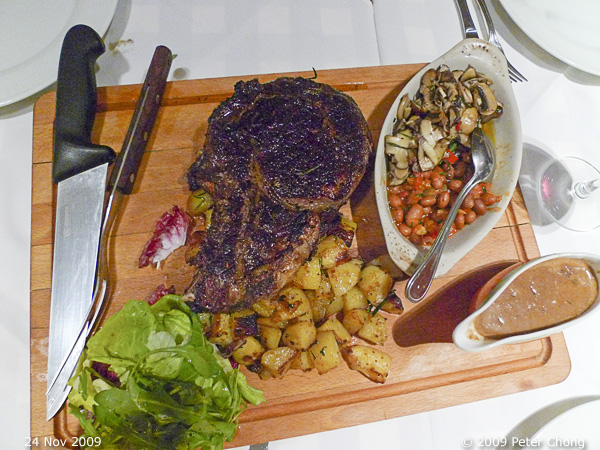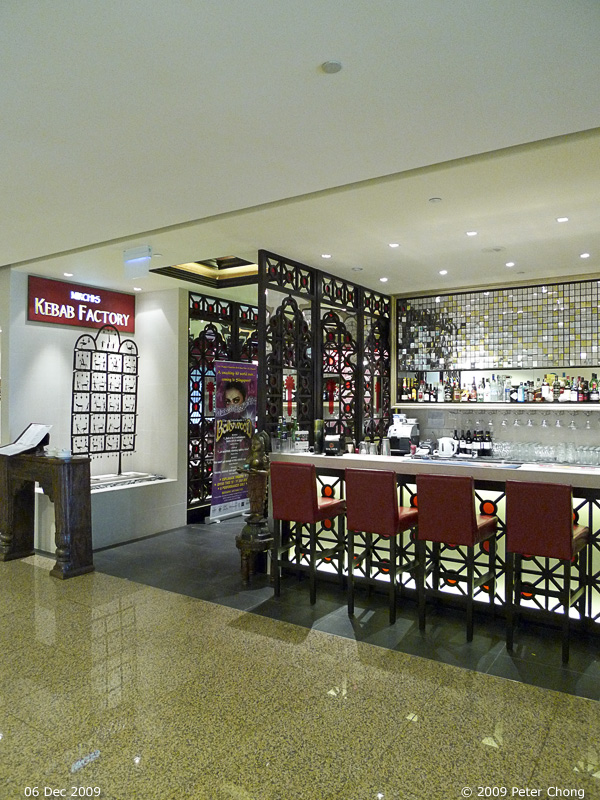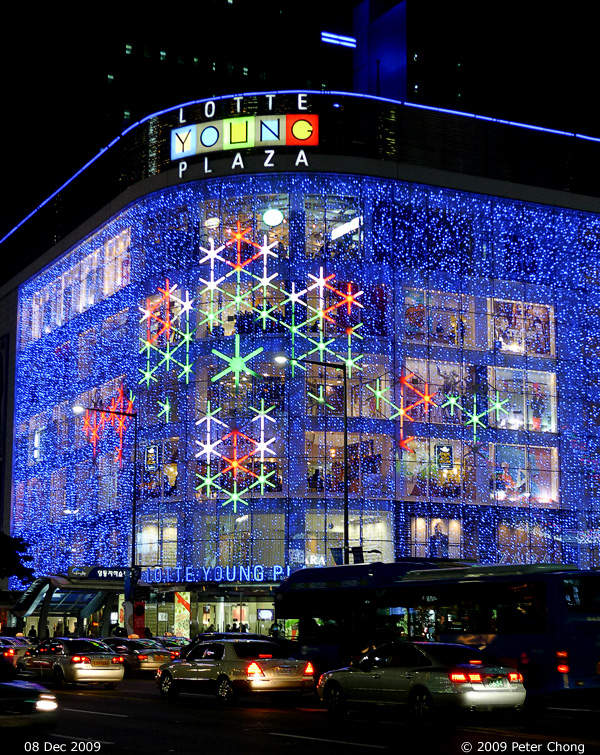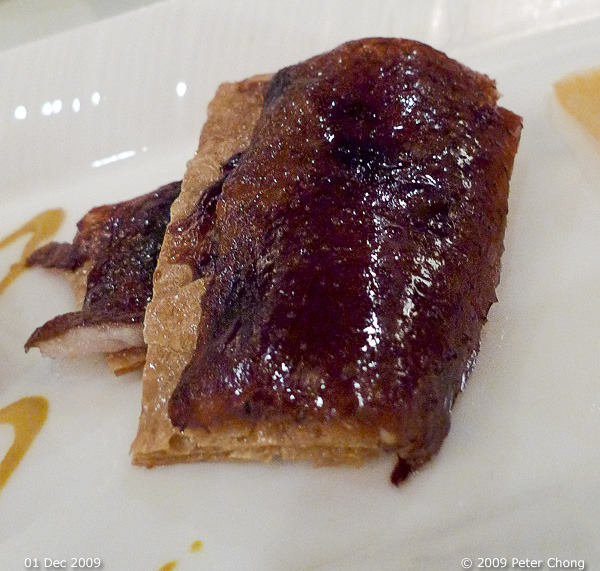with Kin and Prof Massi and Prof FrancesccaMy friends Massi and Francescca are guardians of Italian tradition...especially so for Italian (in particular Florentine) cuisine, as they are both from Florence, and fiercely loyal to the culture. I hold their taste to high regard, and are arbiters for all things Italian.
Massi suggested Lafiandra for our dinner...I browsed the web menu, and found Costata di Manzo alla Fiorentina...I have been always a big fan of a good steak. (yes, regular readers know how big a fan I am). And have always been on the lookout at Italian restaurants for the illusive Chinina cow from Italy offered as bistecca alla Fiorentina. Typically, this is a large (yes very large...min 3 finger thick, according to
Dario Cechini: the most celebrated butcher and steak-monger in Italy.) The Chinina cattle is known to be very large, so the meat yield is very high...meaning large steaks are possible, but very lean meat. Dario would have his beef aged to his specifications, but at Lafiandra, the chef and owner Cataldo, uses Australian cattle which is not dry aged. More about the steaks later.
The restaurant is situated on one wing of the Singapore Arts Museum...the other arm houses Dome. And the decoration within is quite nice...cozy, sophisticated European.

The web reviews of the restaurant is not very good...but most of the complaints were of poor service and that they don't serve plain water until you order drinks. I think this is a rediculous policy, along with the similarly silly notion of charging for plain water in a restaurant. We ordered a bottle of San Pellegrino sparkling water...and a bottle of their house red wine: Montepulciano d'Abruzzo from the house of Farina...a nice red - very soft tannins, delicious fruits, if a bit one dimensional.

Francescca skipped into the kitchen and persuaded Cataldo to add Parmigiani cheese and Rucola onto the Pizza Bianco.

This was a delicious pizza. Pizza bianco is pizza dough, baked on its own, and then topped with ingredients. The regular bianco served at Lafiandra comes with tomatos, basil and olive oil. But the addition of rucola and parmigiani cheese made the pizza even more special. The base dough was excellent...very thin, crispy, and very tasty.
We also had Burratina alla Coratina:

A special kind of soft mozzarella, known as burratina is served with ripe tomato, drizzled with olive oil. The burratina is quite special...made by combining mozzerella with cream...an outer layer consisting of fairly solid (rubbery) mozerella, and a soft, almost liquid core of mozzerella and cream. The tomatoes were quite fresh, and added some acidity to the mild, but rich cheese.
And Massi's favourite eggplants: Involtini di melanzane con mozzarella

Pan fried sliced eggplant rolled with mozzarella cheese and tomato sauce. I enjoyed this dish very much...though Kin thought the tomato sauce was a bit overpowering, I felt it provided the acidity to slice through the rich tasting eggplant.
We shared two Second Plates:
The risotto:

Risotto ai Porcini was excellent. We found it to be a tad too salty, but still quite delicious. The mushrooms were wonderful...fragrant, with bits of succulent mushroom embedded within. The rice was cooked to perfection, and has absorbed the broth very well...this makes tasty risotto, and makes it different from Asian methods of cooking rice...in risotto, the uncooked rice is stirred and broth (either chicken, vegetable or other stock as the chef chooses to bring out a particular flavour) one cupful a time, until the rice is cooked, and usually just al dente.
We also had fresh tagliatelle:

Tagliatelle alla Boscaiola: Flat ribbon pasta with bacon and mushrooms in tomato cream sauce. The tagliatelle was freshly made with just flour, water and eggs on premises. Fresh pasta, when cooked maintains a soft, kway teow like consistency, and not possible to do al dente. The tomato cream sauce was very nicely done. Massi loved this pasta, while Kin and I were a bit indifferent...it was tasty, but not mind-blowingly so.
Next: the main event...the steak.

The piece of meat was substantial. Recommended for a min of 2, it came on the bone, and promised to be a min of 1kg. As can be seen, it was well charred...but the black exterior was not charred crisp, and some sauce has been used to marinate the meat before putting it on a hot skillet. I can detect traces of rosemary leaves still clinging to the steak. Note the groove along the wooden board used to serve the steak...this is for the blood to run off the steak as one carves it...indicting that the steak should be done rare or medium rare...as a good piece of meat should be.

A closer look at the huge piece of beef. This was from Australian (I suspect Black Angus), grass fed cattle. Served on the bone, and uncut...the honours of carving the huge steak being left to the diner. I did the honours and cut it into large bite sized slices...a la Peter Lugers...but not being a master carver...this task was not the easiest to accomplish...but I managed...
Cut open, revealed medium rare as we had ordered.

As can be seen, the cattle has been grass fed, and shows little marbling...the fat remained at the sides of the beef. I later spoke to Cataldo, and he confirmed that the beef was not dry aged. The meat was still excellent...provide good bite for the mouth to masticulate, but we found it to be bit tougher than the best of the genre. The lack of marbling also contributed to playing down on the beefiness flavour. And as the meat was not dry aged, the characteristic intense beef flavours and foie gras flavours were absent. As it were, this is an excellent piece of meat, tasty, albeit a bit chewy, but very good. Would have been better if it were grain fed for 300 days or so, and then dry aged for 21 days...might have rivalled Mamou's or Peter Luger's.
Desserts next. We shared two desserts, both were nice, but not outstanding in any way.

The tiramisu had a generous sprinkling of chocolate, but had a distinct lack of alcohol, though the flavour of coffee was quite strong. The mascarpone cheese was mild, and slightly sweetened and maintained the characteristic near liquid consistency which makes this quite satisfying.

A nut encrusted ice-cream was our other dessert order...this was not made inhouse, but purchased.
We ended with coffee and some liquor: limoncelli and grappa.

The double espresso looked a bit too tall...tasted ok...little mouthfeel, no heavy liquorish sensations. Finish was short. But this is not unexpected from commercial beans, in this case from Segafredo.

The cappucinno clearly looked like it was made with an automatic machine...the foam was too high, and featured an indentation characteristic of the automatic coffee machine. Its taste was unremarkable.

Overall, we enjoyed the meal...a good meal with good friends and great conversation is always a great joy. The restaurant delivered as promised...this was good, traditional, Italian cooking. Not spectacular Michelin style, but good, home-cooked feel. We found the service to be attentive, the servers knowledgable, and good...and other than the silly policy on plain water (they did offer plain iced water after we finished our wine and sparkling water), service was efficient and good.
71 Bras Basah Road
Singapore Art Musuem
#01-02
Singapore 189555
Tel: 68844035
Mondays to Sundays
(Lunch)11.30am to 3pm (Last order at 2.30pm)
(Dinner)6pm till 11pm (Last order at 10.30pm)







































